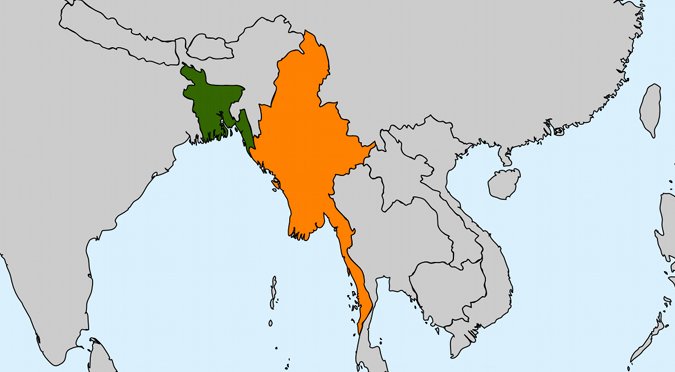By
Human smuggling from the Bangladesh-Myanmar borderland cannot be effectively tackled by short-term quick-fixes. For a sustainable solution, both Bangladesh and Myanmar have to take effective action against human trafficking through building their institutional capacity and addressing the socio-economic causes behind human smuggling.
By Iftekharul Bashar*
With more than two dozen human smuggling syndicates active in the coastal region of Bangladesh and Myanmar bringing boat people to Southeast Asia, human smuggling will remain a key challenge for region. In recent times, Thailand has taken a tough stance against human smuggling and trafficking in persons, but the response from Bangladesh and Myanmar remains inadequate and without a long-term strategy.
Unless Bangladesh and Myanmar take an effective stance against human smuggling, such problems will persist and may even escalate. For a sustainable solution, both the countries should consider a three pronged strategy: firstly to scale up institutional capacity to tackle human smuggling’ secondly, to raise social awareness through the mass media; and thirdly to address their respective socio-economic problems that is marginalising a vulnerable population.
Building institutional capacity and raising awareness
Failure to check human trafficking is a capacity issue in both Bangladesh and Myanmar. Checking human smuggling requires a sound understanding of the local dynamics of the problem, ensuring good intelligence, and good teamwork across multiple agencies. So far in both the countries the police, coast guard, border guard, navy and other agencies have been working separately, which is why there are many security gaps that the smugglers are taking advantage of.
To check human smuggling all the agencies in the respective countries must come together and work in a coordinated manner. Countering human smuggling will require a whole-of-government approach to ensure a quick response. This will eventually be beneficial not only to check human smuggling but also to check all kinds of crime and illegal activities where the coastal areas are used.
Both Bangladesh and Myanmar should engage all the stakeholders in the maritime sector such as marine fisheries and shipping industry. Since the human smuggling syndicates and their associates are based on-shore, it is essential to investigate and take legal action against them.
In addition, Bangladesh and Myanmar must contain more than two dozens of groups involved in human smuggling, of which 11 groups are based in Bangladesh while 13 are based in Myanmar. These groups and their agents and associates are not unknown to the law enforcement agencies in both countries. Bangladesh and Myanmar must work together with the ASEAN countries particularly Malaysia and Thailand as some of the key leaders of these syndicates are based in these two countries.
The human smugglers in Bangladesh and Myanmar are exploiting an uneducated population particularly the stateless Rohingya, a community largely unaware of the risk of the illegal maritime voyage. Both Bangladesh and Myanmar should invest in building social awareness and resilience against human smuggling.
Both the countries can take advantage of the mass media such as radio and television for such campaign. A well-informed community is the first line of defence against human smuggling. Both the governments should consider public awareness-raising campaign both at the national and grassroots levels, particularly those areas where human smuggling syndicates are active.
Addressing socio-economic factors
One of the key causes of human smuggling from the Bangladesh-Myanmar borderland is the fragile socio-economic background of its inhabitants. For nearly four decades, the Rohingya from western Myanmar continue to migrate by crossing the border into Bangladesh or by taking boats to Southeast Asia. Since 1978 more than half a million Rohingya have crossed over to Bangladesh to escape from communal violence and persecution in Myanmar.
Rohingya are an ethnic minority in Myanmar, but are not recognised as citizens by the state despite the fact that they have been living there for centuries. The situation in western Myanmar’s Rakhine state remains volatile and deeply scarred by communal riots since 2012 that left over 200 dead and some 140,000 homeless trapped in displacement camps. The situation remains grim for the Rohingya, with increasing numbers now living in the squalid camps, and many hundreds fleeing the country every day.
According to the UNHCR at least 53,000 people have undertaken irregular maritime journeys in the Bay of Bengal towards Thailand and Malaysia, and several hundred have reportedly died during the journey. In Bangladesh, there are only a little more than 30,000 Rohingya refugees registered with the UNHCR, while more than 470,000 are living as undocumented illegal immigrants in the coastal areas of south-eastern Bangladesh without any protection.
Disowned and rejected by Myanmar, and forgotten by the international community, many Rohingya have ended up in drug trafficking and other illegal activities in Bangladesh, a country that considers the Rohingya refugees and illegal immigrants as an extra burden on the top of its own problems. The local Bangladeshis view the Rohingya as taking away jobs and putting pressure on the limited resources of the area such as land.
As a result many of the Rohingya wants to migrate to South-east Asia for a better livelihood. Their crippling poverty and desperation is eventually being exploited by human smugglers who promise them jobs and a better life in Malaysia, a country where there is still demand for cheap and unskilled manpower.
Though in most cases these groups are involved in smuggling the stateless Rohingya, recently they have been able to attract some Bangladeshi citizens also to take the risky maritime voyage in the Bay of Bengal crossing around 1640 nautical miles to reach Malaysia.
Way forward
While for the Rohingya the key socio-economic push factors are persecution and statelessness, for Bangladeshis, it is the lack of employment opportunities within the country, and growing poverty. In both cases lack of awareness about the risks in the illegal maritime journeys is common. A sustainable solution to the human smuggling problem, therefore, depends on how effectively these two countries address the socio-economic problem of the borderland area.
Checking human smuggling from the Bangladesh-Myanmar borderland needs a long term commitment from both the countries. In addition, other Southeast Asian countries such as Thailand and Malaysia also need to be engaged. Bangladesh and other Southeast Asian countries might consider setting up a high-level taskforce to check human trafficking.
In addition, all these countries should build a common database on human smuggling issues. While capacity building and awareness-raising programmes will certainly help, the ultimate solution to the problem depends on how effectively the socio-economic crisis of the borderland region is resolved.
*Iftekharul Bashar is an Associate Research Fellow at the S. Rajaratnam School of International Studies (RSIS), Nanyang Technological University, Singapore.
Source: Eurasiareview










